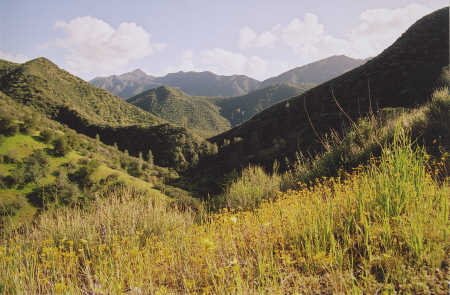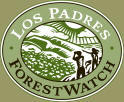Wilderness
in the Los Padres
The
Los Padres contains ten wilderness areas totaling 876,012 acres,
nearly half of the total Los Padres land base. The San Rafael
Wilderness was the first-ever primitive area designated as
wilderness, and the Sisquoc Condor Sanctuary is located within
its boundaries. To the north, the Ventana Wilderness
contains the southernmost stands of ancient coast redwoods, and
is one of only a few coastal wilderness areas in the nation. To
the south, the Sespe Wilderness contains southern California’s
last undammed river – Sespe Creek – as well as the Sespe Condor
Sanctuary and the Piedra Blanca National Recreation Trail.
|
 |
|
A view
of the Sespe Wilderness. © LPFW, Inc. |
As
urban populations expand, wilderness is
experiencing a dramatic rise in visitors, threatening the very
wilderness qualities that these areas were designed to protect. Despite these pressures, the Forest Service is not recommending
a sufficient number of new wilderness areas to meet increased
demand, to provide sufficient habitat, and to ensure sufficient
sources of clean water. There are 36 areas eligible for future
wilderness designation in the Los Padres, yet the Forest Service
is only recommending 7 relatively small areas while ignoring
those areas most in need of protection.
Private lands surrounded by wilderness (called “inholdings”)
also threaten wilderness on the Los Padres. Certain land uses
that occur on these inholdings – such as grazing, mining, road
construction, and other development – are often incompatible
with the surrounding wilderness. Several of these inholdings
exist in wilderness areas of the Los Padres, and threaten to
forever alter wilderness values.
Roadless Areas in the
Los Padres
The Los Padres
contains 37 inventoried roadless areas totaling 636,000 acres,
the second-highest in California. Along the eastern edge of the
Los Padres, the Antimony Mountain roadless area provides
commanding views of the southern Sierra Nevada range and is a
vital wildlife corridor to the Carrizo Plain National Monument. Several roadless areas surrounding the Sespe Wilderness contain
fascinating geologic formations, and are classified as areas of
high ecological significance. The Badlands and Abel roadless
areas supports rare endemic species and is considered sacred by
the native Chumash.
|
 |
|
The
Mono Roadless Area in the Upper Santa Ynez River
watershed. © LPFW, Inc. |
Threatening these
roadless areas is a vast network of interstates, state highways,
and county and forest roads. The Los Padres contains 1,557 miles of roads and an additional 451 miles
of off-highway vehicle routes, representing nearly one mile of
road for every square mile of forest. The Forest Service
lacks the funds to maintain these roads, and about 25% of them
require extensive repairs. The agency also lacks sufficient
resources to prevent illegal roads, as there are over 140 miles
of unclassified roads in otherwise-roadless areas of the Los
Padres.
The
Forest Service is also proposing several controversial road
projects, including reopening the Arroyo Seco-Indians Road along
the Ventana Wilderness boundary. This road has been closed for
several years due to storm damage, and runs along a known
steelhead stream that is being considered for Wild and Scenic
River designation.
The Benefits of Wilderness
Congress passed the Wilderness Act of 1964 in order to “secure
for the American people of present and future generations the
benefits of an enduring resource of wilderness.” Forty years
later, there are now more than 105 million acres of wilderness
across all regions of the country. An additional 60 million
roadless acres remain in our national forests, representing the
last vestiges of undeveloped landscapes in the nation.
Wilderness and roadless areas provide many benefits. These wild
landscapes offer solitude and primitive recreation experiences
such as hiking, backpacking, horseback riding, hunting, and
rockclimbing. They provide sources of clean drinking water for
local communities. They support large blocks of undisturbed
habitat for hundreds of threatened, endangered, and sensitive
species, and play a key role in maintaining native plant and
animal species and biological diversity. In addition, they
provide opportunities for study, research, and education.
These wild places are coming under increasing threats, becoming
choked by a vast network of roads totaling 440,000 miles, enough
to circle the globe 17 times. Every year, another two
hundred miles of roads are constructed through our national
forests. These roads negatively impact the health of our
public lands: they fragment wildlife habitat, degrade water
quality and fish habitat, and increase erosion and sedimentation
into streams, lakes, and rivers. In fact, roads contribute
more sediment into streams than any other activity on public
lands. In addition, forest roads facilitate illegal
vehicle trespass, resource extraction, and the subsequent loss
of forest habitat. The Forest Service currently has an
$8.4 billion backlog in road maintenance, leading many to
question the wisdom of building new roads when existing roads
are in disrepair. |

